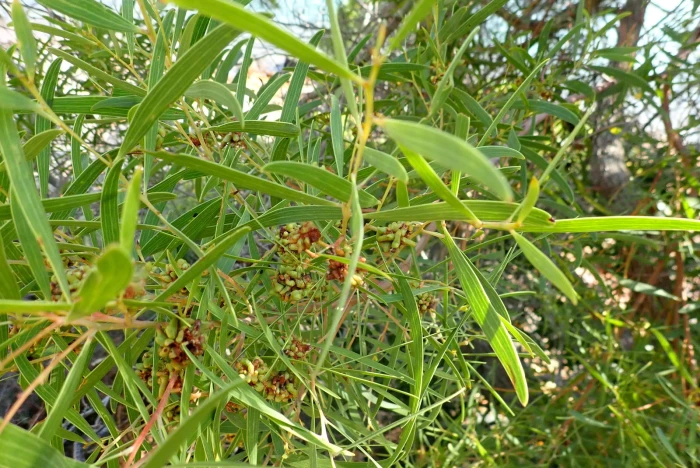Coastal Wattle
(Acacia cyclops)
Coastal Wattle (Acacia cyclops)
/
/

Nicola van Berkel
CC BY-SA 4.0
Image By:
Nicola van Berkel
Recorded By:
Copyright:
CC BY-SA 4.0
Copyright Notice:
Photo by: Nicola van Berkel | License Type: CC BY-SA 4.0 | License URL: http://creativecommons.org/licenses/by-sa/4.0/ | Rights Holder: Nicola van Berkel | Publisher: iNaturalist | Date Created: 2019-03-07T09:33:03-08:00 |

























Estimated Native Range
Climate Requirements for Nanchang, China
| This Plant | Your Site | Plant Suitability for Your Location | ||
|---|---|---|---|---|
| • Precipitation | 1" - 59" | 62" | Aquatic | Aquatic |
| • High Temp. | 70°F - 102°F | 93°F | Your summer temperatures are normal for this plant. | Excellent |
| • Low Temp. | 28°F - 59°F | 37°F | Your winter temperatures are normal for this plant | Excellent |
This plant may not grow well at your location - your precipitation is too high.
Summary
Acacia cyclops, commonly known as Coastal Wattle or Red-eyed Wattle, is a perennial shrub or small tree native to coastal dunes and limestone outcrops in Western and South Australia. It typically grows to a height of up to 26 feet (8 meters), with a dense, dome-shaped canopy. This species is characterized by its phyllodes, which are modified leaf stems that function like leaves, and its distinctive red-tinged seed pods. The bright yellow, spherical flower clusters are highly ornamental and bloom from late winter to mid-summer, providing extended seasonal interest.
Coastal Wattle is valued for its hardiness, fast growth, and ability to stabilize soil, making it useful for erosion control in coastal areas. It is also used in gardens for its vibrant flowers and as a windbreak or privacy screen. Acacia cyclops thrives in full sun and is tolerant of a variety of soil types, provided they are well-drained. It is drought-tolerant once established, requiring minimal water. However, it can become invasive outside its native range, so it is essential to consult local guidelines before planting.CC BY-SA 4.0
Coastal Wattle is valued for its hardiness, fast growth, and ability to stabilize soil, making it useful for erosion control in coastal areas. It is also used in gardens for its vibrant flowers and as a windbreak or privacy screen. Acacia cyclops thrives in full sun and is tolerant of a variety of soil types, provided they are well-drained. It is drought-tolerant once established, requiring minimal water. However, it can become invasive outside its native range, so it is essential to consult local guidelines before planting.CC BY-SA 4.0
Plant Description
- Plant Type: Shrub, Tree
- Height: 2.5-12 feet
- Width: 9.75-11 feet
- Growth Rate: Rapid
- Flower Color: Yellow
- Flowering Season: Spring
- Leaf Retention: Evergreen
Growth Requirements
- Sun: Full Sun, Part Shade
- Water: Medium
- Drainage: Fast, Medium, Slow
Common Uses
Drought Tolerant, Erosion Control, Low Maintenance
Natural Habitat
Coastal dunes and limestone outcrops in Western and South Australia
Other Names
Common Names: Red-eyed Wattle, Cyclops Acacia, Red Eye, Cyclops Wattle, One-Eyed Wattle, Redwreath Acacia
Scientific Names: Acacia cyclops, Acacia cyclopis, Acacia cyclopis, Acacia cyclopis, Acacia cyclopis, Acacia cyclops, Acacia cyclopsis, Acacia eglandulosa, Acacia mirbelii
GBIF Accepted Name: Acacia cyclops